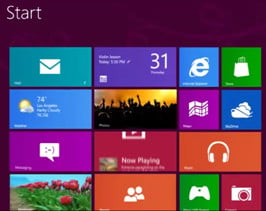Microsoft knows it has to do something in order to claw back some kind of market position, not now but five years into the future. The culture of computing is changing amongst the young and hip consumer, and it's moving away from the Microsoft Windows-centric vision of the past. While Microsoft remains buoyant within the enterprise, powering business globally with plenty of success, the Seattle tech giant would do well to realise that even this core part of the corporate plan is not immune to the generation now effect. What consumers want today can, indeed almost certainly does, influence how enterprises react tomorrow. And that's where the real problems are for Microsoft and the launch later today of Windows 8.
 The latest version of Windows has changed beyond all recognition, or at least it has from the Microsoft perspective. Truth be told, it's pretty old news for the tablet toting, screen swiping, design desiring, cloud-based trend setters of today. I heard Steve Ballmer, Microsoft CEO, talking up Windows 8 on the radio earlier today and he spoke excitedly in terms of how this is as big as the first IBM PC for example, and how Microsoft is re-imagining the world from the world up with Windows 8. Certainly it needs to be a success if Microsoft is to get a proper foothold, even at the very bottom of a very tall ladder, on the smartphone and tablet market where Apple with iOS and Google with Android rule supreme right now.
The latest version of Windows has changed beyond all recognition, or at least it has from the Microsoft perspective. Truth be told, it's pretty old news for the tablet toting, screen swiping, design desiring, cloud-based trend setters of today. I heard Steve Ballmer, Microsoft CEO, talking up Windows 8 on the radio earlier today and he spoke excitedly in terms of how this is as big as the first IBM PC for example, and how Microsoft is re-imagining the world from the world up with Windows 8. Certainly it needs to be a success if Microsoft is to get a proper foothold, even at the very bottom of a very tall ladder, on the smartphone and tablet market where Apple with iOS and Google with Android rule supreme right now.
According to analysts Forrester, the Microsoft share of the personal device market, which includes PCs as well as tablets and smartphones, is around a third today. A few short years back Microsoft enjoyed a 95% stranglehold over the then dominant PC market, before the boom in touchscreen mobility. So can Windows 8 save Microsoft? Many think that's a big ask. Heck, even the timing of the Windows 8 launch could hardly be worse, considering the headline space stolen by Apple with the launch of the iPad Mini at the start of the week and the headlines criticising the Microsoft Surface in reviews this week as well. Not a good springboard from which to launch the platform that Microsoft has everything pinned on.
The radical overhaul of Windows 8 is such that it could even have got away with being called something different, in fact something different might not have been a bad idea; an opportunity for Microsoft to move away from the past and launch itself as a new brand, a new player in the market of tomorrow. A change of name might also have prevented the inevitable problems that many users of Windows 7, and perhaps more tellingly the versions of the OS that came before, who upgrade and find themselves in totally alien territory will experience. Isolating a big lump of your own, loyal, userbase is no way to encourage that loyalty to continue. One of the biggest design specialists in Europe, Foolproof, carried out research with real users to find out what they thought of Windows 8. The results were less than encouraging for Microsoft, with typical user comments including:
"I feel like a baby again. I can’t do anything…” and "That wasn’t a natural place to go look for search….”
John Waterworth, a senior practitioner at Foolproof, says the research "highlights the huge pain barrier that even the most experienced user will have to go through to get to grips with the Windows 8 UI. Even assuming it takes the average user a - highly-conservative - couple of hours to come to terms with the changes, this would imply the loss of more than 300,000 man-years of productivity worldwide. Microsoft will need very broad shoulders to weather the likely backlash from consumers on social media, which we believe could last as long as 2-3 years.”
